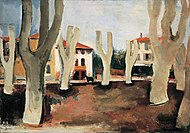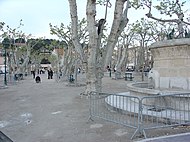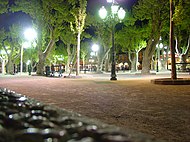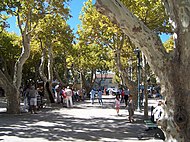
Bocce, sometimes anglicized as bocce ball, bocci or boccie, is a ball sport belonging to the boules family, closely related to British bowls and French pétanque, with a common ancestry from ancient games played in the Roman Empire. Developed into its present form in Italy, bocce is played around Europe and also in other areas with Italian immigrants, including Australia, North America, and South America. Initially played only by the Italian immigrants, the game has slowly become more popular with their descendants and more broadly.

Henri Émile Benoît Matisse was a French artist, known for both his use of colour and his fluid and original draughtsmanship. He was a draughtsman, printmaker, and sculptor, but is known primarily as a painter. Matisse is commonly regarded, along with Pablo Picasso, as one of the artists who best helped to define the revolutionary developments in the visual arts throughout the opening decades of the twentieth century, responsible for significant developments in painting and sculpture.

Pétanque is a sport that falls into the category of boules sports, along with raffa, bocce, boule lyonnaise, lawn bowls and crown green bowling. In all of these sports, players or teams play their boules/balls towards a target ball.

Pointillism is a technique of painting in which small, distinct dots of color are applied in patterns to form an image.

Paul Victor Jules Signac was a French Neo-Impressionist painter who, working with Georges Seurat, helped develop the Pointillist style.

The French Riviera is the Mediterranean coastline of the southeast corner of France. There is no official boundary, but it is usually considered to extend from Cassis, Toulon or Saint-Tropez on the west to Menton at the France–Italy border in the east, where the Italian Riviera joins. The coast is entirely within the Provence-Alpes-Côte d'Azur region of France. The Principality of Monaco is a semi-enclave within the region, surrounded on three sides by France and fronting the Mediterranean. Riviera is an Italian word that corresponds to the ancient Ligurian territory, wedged between the Var and Magra rivers. The "Côte d'Azur" is a nickname given by Stéphen Liégeard, a French writer, in his novel La Côte d'azur, to describe the coast between Marseilles and Genoa.
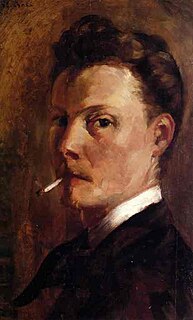
Henri-Edmond Cross, born Henri-Edmond-Joseph Delacroix, was a French painter and printmaker. He is most acclaimed as a master of Neo-Impressionism and he played an important role in shaping the second phase of that movement. He was a significant influence on Henri Matisse and many other artists. His work was instrumental in the development of Fauvism.

Saint-Tropez is a town on the French Riviera, 68 kilometres west of Nice and 100 kilometres east of Marseille in the Var department of the Provence-Alpes-Côte d'Azur region, Southern France.
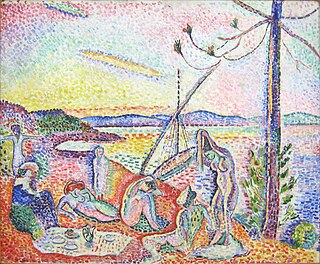
The Société des Artistes Indépendants, Salon des Indépendants was formed in Paris on 29 July 1884. The association began with the organization of massive exhibitions in Paris, choosing the slogan "sans jury ni récompense". Albert Dubois-Pillet, Odilon Redon, Georges Seurat and Paul Signac were among its founders. For the following three decades their annual exhibitions set the trends in art of the early 20th century, along with the Salon d'Automne. This is where artworks were often first displayed and widely discussed. World War I brought a closure to the salon, though the Artistes Indépendants remained active. Since 1920, the headquarters is located in the vast basements of the Grand Palais.

Divisionism was the characteristic style in Neo-Impressionist painting defined by the separation of colors into individual dots or patches which interacted optically.

Labège is a commune in the Haute-Garonne department in the Occitanie region in southwestern France.

Stefan Szczesny is a German painter, draughtsman, and sculptor. He is best known for co-founding the Neue Wilde movement in the early 1980s.

Félix Fénéon was a French anarchist and art critic during the late 19th century. He coined the term Neo-Impressionism in 1886 to identify a group of artists led by Georges Seurat, and ardently promoted them.

Luxe, Calme et Volupté is an oil painting by the French artist Henri Matisse. Both foundational in the oeuvre of Matisse and a pivotal work in the history of art, Luxe, Calme et Volupté is considered the starting point of Fauvism. This painting is a dynamic and vibrant work created early on in his career as a painter. It displays an evolution of the Neo-Impressionist style mixed with a new conceptual meaning based in fantasy and leisure that had not been seen in works before.

Louis Valtat was a French painter and printmaker associated with the Fauves, who first exhibited together in 1905 at the Salon d'Automne. He is noted as a key figure in the stylistic transition in painting from Monet to Matisse.

Fauvism /fʊvism/ is the style of les Fauves, a group of early 20th-century modern artists whose works emphasized painterly qualities and strong color over the representational or realistic values retained by Impressionism. While Fauvism as a style began around 1904 and continued beyond 1910, the movement as such lasted only a few years, 1905–1908, and had three exhibitions. The leaders of the movement were André Derain and Henri Matisse.
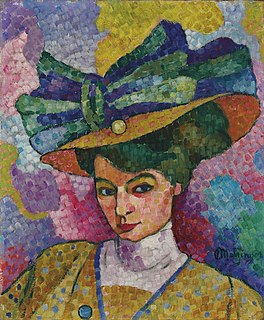
Femme au Chapeau or Woman with a Hat is an oil painting created circa 1906 by the French artist and theorist Jean Metzinger (1883–1956). The work is executed in a highly personal Divisionist style with a marked Proto-Cubist component during the height of Fauvism. Femme au Chapeau exhibits a presentiment of Metzinger's subsequent interest in the faceting of form associated with Cubism. The painting now forms part of the collection of the Korban Art Foundation.
Jeanne Selmersheim-Desgrange (1877–1958) was a French neo-impressionist painter who used the art technique of pointillism with her main themes of flowers and gardens. Her painting, Garden at La Lune, Saint-Tropez (1909), shows her signature use of “high-key colors and block-like strokes.”

Barques de pêche–Méditerranée is an oil on canvas painting by Belgian painter Theo van Rysselberghe. Painted in 1892, it depicts a fleet of sailboats off the southern coast of France. Van Rysselberghe's pontillist technique is well expressed in this work, whose wooden liner was painted with dots of contrasting hues serving to amplify the color harmonies in the canvas. The painting was realized by Van Rysselberghe during a two-month sailing excursion in le Midi with his close friends Paul Signac, and it offers visual representation of that sailing journey.
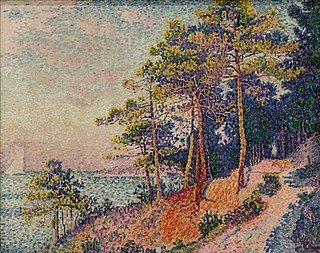
Le Sentier des douanes is a Pointillist-divisionist oil on canvas painting by Paul Signac, measuring 72 by 92.5 cm. It shows the 'Sentier des Douanes', a seaside path in Saint-Tropez. The work now hangs in the musée de Grenoble, to which it was left in 1923 by Georgette Agutte and Marcel Sembat.




